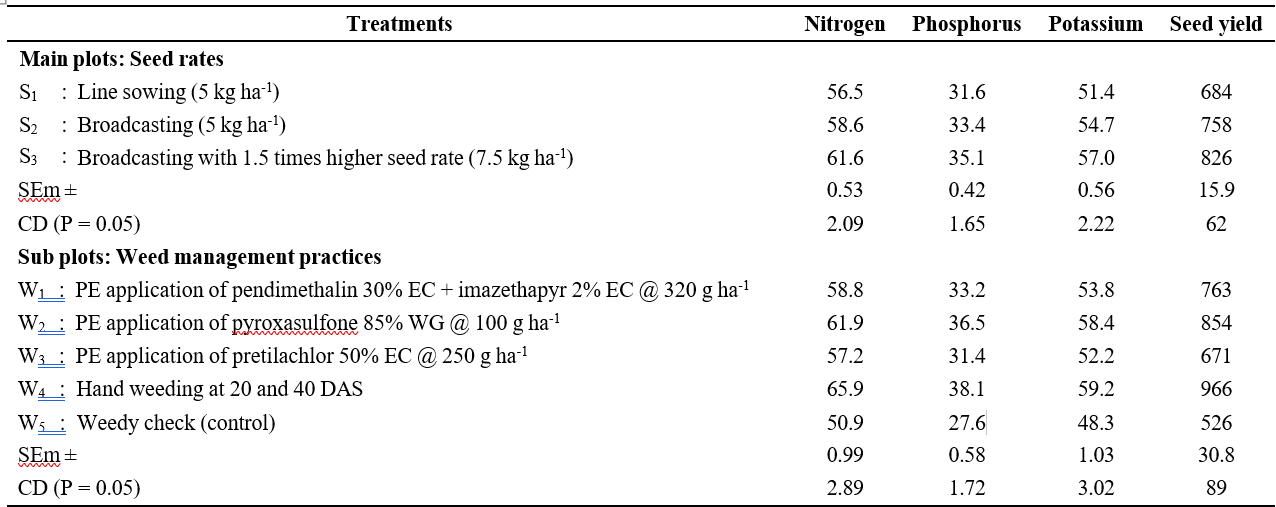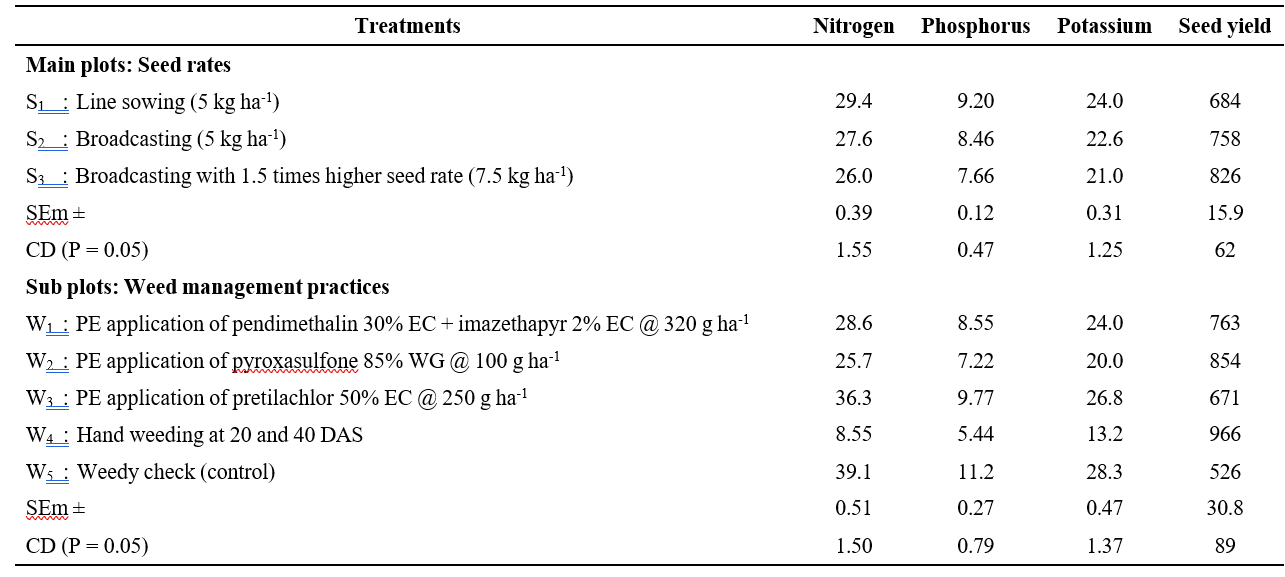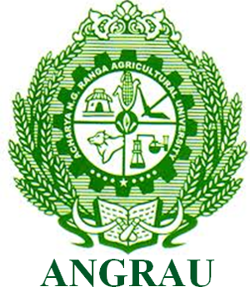Influence of Seed Rates and Weed Management Practices on Nutrient Uptake and Yield of Sesame (Sesamum Indicum L.)
0 Views
M. GIRIDHAR*, P. MAHESWARA REDDY, C. NAGAMANI, M. MADHAN MOHAN AND V. CHANDRIKA
Department of Agronomy, S.V. Agricultural College, ANGRAU, Tirupati-517 502.
ABSTRACT
A field experiment was conducted during rabi, 2023-24 at S.V. Agricultural College Farm, Tirupati. The experiment was laid out in split-plot design and replicated thrice. The treatments consisted of seed rates viz., line sowing (S1), broadcasting with recommended seed rate (S2) and broadcasting with 1.5 times higher seed rate (S3) assigned to main plots and five weed management practices viz., PE application of pendimethalin + imazethapyr 320 g ha-1 (W1), PE application of pyroxasulfone 100 g ha- 1 (W2), PE application of pretilachlor 250 g ha-1 (W3), hand weeding twice at 20 and 40 DAS (W4) and unweeded check (W5) allotted to sub-plots. Among the methods of sowing, highest uptake of N, P and K by sesame was with broadcasting with 1.5 times higher seed rate. Hand weeding twice recorded significantly higher N, P and K uptake by sesame crop compared to other four weed management practices. Lower nutrient uptake of N, P and K by crop was with unweeded check.
KEYWORDS: Sesame, Seed rates, Pre-emergence herbicides, Nutrient uptake.
INTRODUCTION
Sesame (Sesamum indicum L.) belonging to the family Pedaliaceae is the earliest domesticated oil seed crops of India and grown in the tropics and subtropics, in warm climates. Oleic and linolenic acids, which make up the majority of the polyunsaturated fatty acids in sesame oil, range in percentage from 30.9 to 52.5%. India is among the largest exporters of sesame and ranks first in both acreage (1.627 million hectares) and production (0.789 million tonnes) with the average productivity of 485 kg ha-1 during 2021-22. In Andhra Pradesh, sesame is cultivated in an area of 0.40 lakh hectares with a production of 0.08 lakh tonnes and with the productivity of 215 kg ha-1 during 2021-22 (www.indiastat.com). In most of the areas sesame crop is heavily infested by weeds and thereby resulting in heavy yield loss ranging from 16 to 68 per cent. The period from 15- 30 days after sowing is the most critical period of crop-weed competition in sesame. Along with other agronomic considerations, the main determinants of crop vigor and final yield are seed rate and sowing technique. In this situation, higher seeding rates have a smothering effect that inhibits weed growth. One strategy to improve crop competitiveness against weeds is to seed at a higher rate. Therefore, to reduce the yield losses brought on by weeds under various seed rates, weed management with pre- emergence herbicides is crucial in sesame.
MATERIAL AND METHODS
The field experiment was conducted at S.V. Agricultural College, Tirupati campus of Acharya N.G. Ranga Agricultural University, Andhra Pradesh during rabi, 2023-24. The soil at the experimental site was sandy loam in texture, neutral in reaction, low in organic carbon (0.27%), available nitrogen (151 kg ha-1), medium in available phosphorus (24.2 kg ha-1) and available potassium (181 kg ha-1). The experiment was laid out in split- plot design and replicated thrice. The treatments consisted of three seed rates (3) viz., line sowing (S1), broadcasting with recommended seed rate (S2) and broadcasting with 1.5 times seed rate (S3) assigned to main plots and five weed management practices (5) viz., PE application of pendimethalin + imazethapyr @ 320 g ha-1 (W1), PE application of pyroxasulfone @ 100 g ha-1 (W2), PE application of pretilachlor @ 250 g ha-1 (W3), hand weeding at 20 and 40 DAS (W4) and unweeded check (Control) (W5) allotted to sub plots. In line sowing 30 cm x 15 cm spacing with recommended seed rate of 5 kg ha-1, broadcasting with recommended seed rate of 5 kg ha-1 and broadcasting with 1.5 times higher seed rate of 7.5 kg ha-1. The variety sarada (YLM- 66) was sown on 7th of January, 2023 and recommended dose of the fertilizer applied was 40-20-20 N-P2O5-K2O kg ha-1. Composite plant samples of both the crop and weeds from all plots were collected at harvest. These samples were then dried, ground into a fine powder, and analyzed for nitrogen (N), phosphorus (P), and potassium (K) content using the standard procedures outlined by Jackson (1973). The uptake of N, P, and K by both the crop and associated weeds were determined by multiplying the nutrient content by the corresponding dry weights and expressed as kg ha-1. Additionally, all other recommended agronomic practices were followed as per the crop requirements recommended by ANGRAU.
Nutrient uptake by crop was calculated by using the formula,
Nutrient uptake (kg ha-1) =

RESULTS AND DISCUSSION
The nutrient uptake by sesame crop was significantly influenced by both seed rates and weed management practices. However, the interaction between these two factors did not show a statistically significance (Table 1).
Among the seed rates, broadcasting with 1.5 times higher seed rate resulted in the highest uptake of nitrogen (N), phosphorus (P), and potassium (K) by sesame. This improvement in nutrient uptake is attributed due to the lower weed infestation associated with this sowing method. These outcomes were in line with the results reported by Bhavani et al. (2023) and Rajpurohit et al. (2017). Regarding weed management practices, hand weeding was most effective in enhancing the uptake of N, P, and K. This is likely due to the increased dry matter accumulation and higher nutrient content in sesame when weeds are controlled manually. The study also suggests that there is an inverse relationship between nutrient uptake by the crop and by the associated weeds. This information underscores the importance of effective sowing method and efficient weed management practices to optimize nutrient uptake in sesame. The weedy check treatment resulted in low nutrient uptake by crop due to heavy weed infestation with a tune of 50.9, 27.6, 48.3 kg ha-1 N, P, K respectively.
Nutrient uptake by weeds was significantly influenced by both seed rates and weed management practices. However, the interaction between these two factors did not yield statistically significant results
(Table.2). Among the seed rates, line sowing with recommended seed rate of 5 kg ha-1 resulted in the highest uptake of nitrogen (N), phosphorus (P), and potassium (K) by weeds. This is attributed due to the higher weed population associated with line sowing, which aligns with the findings of Elhag et al. (2019) and Sharma and Singh (2011). Regarding weed management practices, the highest nutrient uptake by weeds was observed in the weedy check plots. This was significantly higher compared to other weed management practices, primarily due to intense competition for nutrients between the weeds and the crop. The nutrient uptake due to heavy weed infestation in unweeded check was 39.1, 11.2, 28.3 kg ha-1 N, P, K respectively.
Seed yield of sesame differed significantly with seed rates and weed management practices. Highest seed yield (826 kg ha-1) was with broadcasting higher seed rate (S3) which was significantly higher than the broadcasting at recommended seed rate (S2) (758 kg ha-1). Line sowing (S1) resulted in significantly lower sesame seed yield (684 kg ha-1). (Table 1).
Higher seed yield with increase in seed rate appears to be due to higher sesame plant population which smothered weed growth leading to efficient use of growth resources. Increase in seed yield with relatively higher seed rate has been reported by Khanam et al. (2021), Islam et al. (2014) and Daniya et al. (2015). But the most important reason for yield improvement with increased density can be attributed to the number of plants growing in a field unit (Moosazadeh et al., 2010). The lowest seed yield of sesame in line sowing might be due to relatively lesser sesame plant density for efficient use of available growth resources as reported by Wasanthika et al. (2022) and Abdel-Latief et al. (2022). Among the weed management practices, highest seed yield of sesame (966 kg ha-1) was observed with hand weeding (W4) which was significantly superior over rest of the weed management practices. Pre emergence application of pyraxosulfone (W2) was the next best treatment with the seed yield of 854 kg ha-1. Seed yield decreased in the order of hand weeding (W4) (966 kg ha-1), pyroxasulfone (W2) (854 kg ha-1), pendimethalin + imazethapyr (W1) (763 kg ha-1), pretilachlor (W3) (671 kg ha-1) and unweeded check (W5) (526 kg ha-1). Higher number of capsules plant-1 and more number of seeds capsule-1 as a result of reduced competition for growth resources by weeds, improved the yield attributesof sesame crop leading to higher seed yield.
Table 1. Nutrient uptake (kg ha-1) and Seed yield (kg ha-1) of sesame influenced by seed rates and weed management practices

Table 2. Nutrient uptake (kg ha-1) by weeds at harvest in sesame as influenced by seed rates and weed management practices

These results are in agreement with those of Joshi et al. (2022), Venu et al. (2022), Audu et al. (2021) and Sangeetha and Chinnamuthu (2019). Lower seed yield of sesame with weedy check (W5) might be due to heavy weed competition for growth resources, leading to poor partitioning of photosynthates from source to sink (Singh
et al., 2018).
The present investigation has revealed that higher nutrient uptake and yield of sesame was resulted in case of broadcasting with 1.5 times higher the seed rate (7.5 kg ha-1) along with hand weeding twice at 20 and 40 DAS.
LITERATURE CITED
Abdel-Latief, E.A., Hassan, M.S., Abo-Al-Aze, A.A and Ramadan, M.A. 2022. Effect of planting dates and methods of sowing on productivity of sesame under Toshka conditions. SVU-International Journal of Agricultural Sciences. 4(2): 96-106.
Audu, I., Wamduda, D and Lawrence, T. 2021. Growth, Yield and Yield components of Sesame (Sesamum indicum L.) as Influenced by Crop Variety and Different Rates of Herbicides in Mubi, Adamawa State, Nigeria. International Journal of Environment, Agriculture and Biotechnology. 6: 2.
Bhavani, R., Reddy, G.K., Reddy, P.M., Kumari, P.L and Sagar, G.K. 2023. Nutrient uptake as influenced by methods of sowing and weed management practices in summer sesame (Sesamum Indicum L.). Andhra Pradesh Journal of Agricultural Sciences. 9(2): 100-103.
Daniya, E., Salihu, A.D., Williams BN., Chiroma, K and Bashir, A.B. 2015. Effect of seed rate and nitrogen fertilizer on weed species composition, density and diversity in two sesame varieties. Journal of Agriculture and Soil Science. 61(2): 553-567.
Elhag, D. 2019. Efficiency of sowing method and weed control on growth, yield and quality of linseed (Linum usitatissimum L.). Egyptian Journal of Agronomy. 41(1): 59-68.
Islam, M.K., Khanam, M.S., Maniruzzaman, M., Alam, I and Huh, M.R. 2014. Effect of seed rate and manual weeding on weed infestation and subsequent crop performance of sesame (Sesamum indicum L.). Australian Journal of Crop Science. 8(7): 1065-1071.
Jackson, M.L. 1973. Soil chemical analysis. Prentice Hall of India Pvt. Ltd. Joshi, N., Joshi, S., Sharma, J.K., Shekhawat, H.S and Shukla, U.N. 2022. Efficacy of sequential application of pre and post-emergence herbicides for weed management in sesame. Indian Journal of Weed Science. 54(3): 279-282.
Khanam, A., Salam, M.A., Uddin, M.R., Rabbani, M.G and Hoshain, S. 2021.Effect of sowing methods and weeding regimes on the yield of sesame (Sesamum indicum L.). Research in Agriculture Livestock and Fisheries. 8(3): 291-299.
Moosazadeh, M., Baradaran, R and Segatoleslami, J. 2010. Studying on the effect of plant density and urea on yield, yield components of black seed (Nigella sativa). Iranian Agriculture Research Journal. 8(1): 42-48.
Rajpurohit, D.S., Arvadia, L.K and Jangir, R. 2017. Growth and yield of summer sesamum (Sesamum indicum L.), dry weight of weeds and weed control efficiency influence by different row spacing and weed management under south Gujarat condition. International Journal of Current Microbiology and Applied Sciences. 6(8): 2493-2501.
Sangeetha, K and Chinnamuthu, C.R. 2019. Effect of chemical weed management practices on economics of irrigated sesame cultivation in western zone of Tamil Nadu. International Journal of Chemical Studies. 7(4): 144-147.
Sharma, S.N and Singh R.K. 2011. Seed rate and weed management on yield andnutrient uptake of wheat (Triticum aestivum). Indian Journal of Agricultural Sciences. 81(12): 1174-1179.
Singh, R., Ghosh, D., Dubey, R.P and Singh, V.P. 2018. Weed control in sesame with pre-emergence herbicides. Indian Journal of Weed Science. 50(1): 91-93.
Venu, M.G., Reddy, S.N., Mahesh, U.D.M and Devi, M.U. 2022. Effect of integrated weed management practices on growth and yield of sesame (Sesamum indicum L.). Biological Forum and International Journal. 14(2a): 271-275.
Wasanthika, H.M.N., Edirimanna, I.C.S., Nashath, M.N.F., Mubarak, A.N.M and Kumara, A.D.N.T. 2022. Effect of seed pelleting on the growth and yield performance of sesame (Sesamum indicum L.) cultivation. Sri Lankan Journal of Technology. 3(1) 24-29.
- Production Potential of Sweet Corn as Influenced by Organic Manures and Foliar Nutrition
- Characterization of Grain Iron and Zinc Content in Little Millet Genotypes
- Faunistic Studies on Economically Important Lepidopterans in Different Field Crops of Tirupati District
- An Annotated Checklist of Cyperceae, Eriocaulaceae and Potamogetonaceae of Chhattisgarh
- Genetic Divergence Studies for Yield, Yield Components and Resistance to Late Leaf Spot in Groundnut (Arachis Hypogaea L.)
- Effect of Organic Farming on Soil Enzymatic Activity and Productivity of Groundnut Based Cropping System

